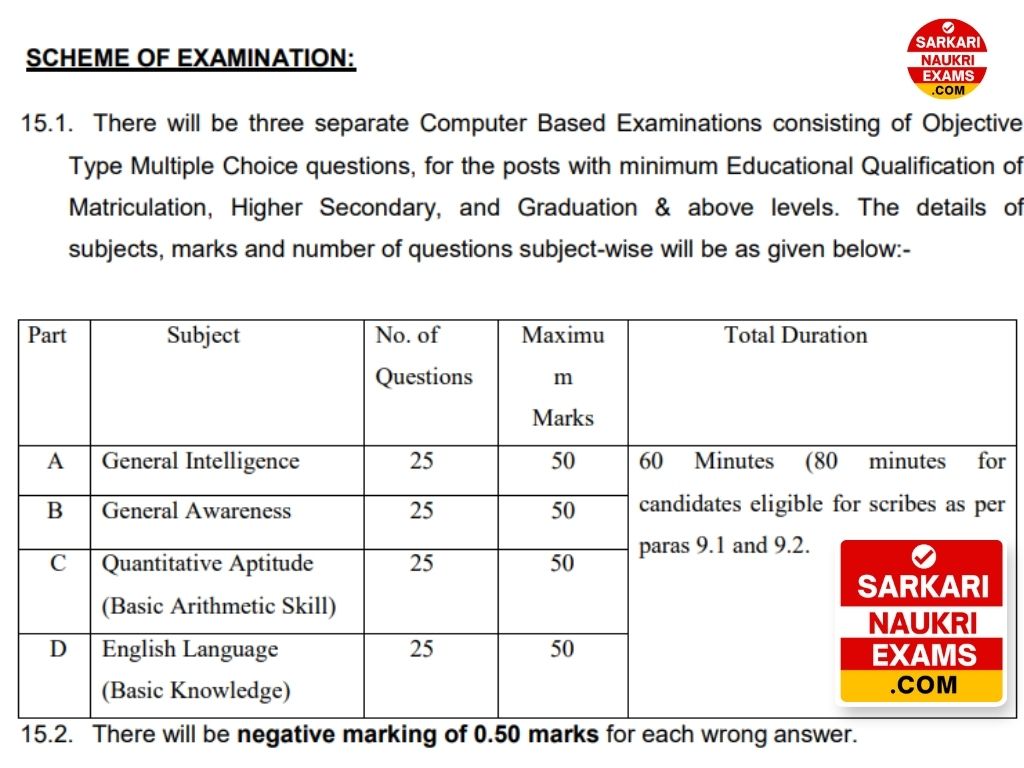SSC Selection Post Syllabus 2025 Phase 11 | PDF in Hindi & English

The SSC Selection Post Syllabus 2025 is designed to test the knowledge and skills of candidates who have completed their 10th, 12th, or undergraduate education. As part of the SSC Selection Post Phase 11 Syllabus 2025, the exam will be bilingual and conducted online. The exam will consist of one paper with 100 multiple-choice questions, and candidates will have one hour to complete the test. The maximum marks for the paper are 200, with each correct answer awarded two marks. However, a wrong answer will result in a penalty of a -1/2 mark.
The selection process includes an online CBT, skill test, medical exam, and verification. The cut-off percentage for selection varies depending on the category, with UR candidates requiring a minimum of 30%, OBC and EWS candidates requiring a minimum of 25%, and other categories requiring a minimum of 20%.
The paper consists of four sections, including General Intelligence, General Awareness, Quantitative Aptitude, and English Language, each containing 25 questions and 50 marks. Overall, the SSC Selection Post Syllabus 2025 is comprehensive and challenging, designed to identify the most qualified candidates for the selection process.
SSC Selection Post Syllabus 2025 ⬇
EXAM LEVEL
10th, 12th & UG
MEDIUM
Bilingual
EXAM MODE
Online Exam
TOTAL PAPER
01 (One)
EXAM TYPE
Objective(MCQ)
QUESTIONS
100
TOTAL TIME
01 Hour
TOTAL MARK
200
RIGHT ANS
2 Mark
WRONG ANS
-1/2 Mark
SELECTION
Online CBT
Skill Test
Medical Exam
Verification
CUT OFF (%)
UR: 30%
OBC: 25%
EWS: 25%
Other: 20%
SSC Selection Post Syllabus 2025 Phase 11 - Matriculation (10th)
General Intelligence (सामान्य बुद्धिमत्ता) MATRIC
- समानताएं और अंतर (Similarities and Differences)
- अंतर्दृष्टि (Space Visualization)
- समस्या हल करना (Problem Solving)
- विश्लेषण (Analysis)
- निर्णय लेना (Judgment)
- दृष्टिकला की स्मृति (Visual Memory)
- भेदभावपूर्ण अवलोकन (Discriminating Observation)
- संबंध अवधारणा (Relationship Concepts)
- आकृति वर्गीकरण (Figure Classification)
- अंकगणितीय संख्या श्रृंखला (Arithmetical Number Series)
- गैर-शब्दात्मक श्रृंखला (Non-Verbal Series)
इस परीक्षा में उम्मीदवार की अभिरूचि और प्रतीकों के साथ उनके संबंध, अंकगणितीय गणना और अन्य विश्लेषणात्मक कार्यों को निपटाने की क्षमताओं का जांच किया जाएगा। (This test will test the candidate's aptitude and ability to deal with symbols and their relation, arithmetical calculations and other analytical functions.)
General Awareness (सामान्य जागरूकता) MATRIC
- General Awareness of the Environment (पर्यावरण की सामान्य जागरूकता)
- Application of Environment to Society (पर्यावरण का समाज पर प्रभाव)
- Knowledge of Current Events (वर्तमान घटनाओं की जानकारी)
- Matters of Everyday Observation and Experience (रोज़मर्रा की अवलोकन और अनुभव से संबंधित मुद्दे)
- Scientific Aspects of Everyday Observation and Experience (रोज़मर्रा की अवलोकन और अनुभव के वैज्ञानिक पहलू)
- Knowledge of India and its Neighboring Countries (भारत और उसके पड़ोसी देशों की जानकारी)
- Sports (खेल)
- History (इतिहास)
- Culture (संस्कृति)
- Geography (भूगोल)
- Economic Scene (आर्थिक स्थिति)
- General Polity (सामान्य राजनीति)
- Indian Constitution (भारतीय संविधान)
- Scientific Research (वैज्ञानिक अनुसंधान)
- Questions that Do Not Require Special Study of Any Discipline (किसी भी विषय के विशेष अध्ययन की जरूरत न होने वाले प्रश्न)
Quantitative Aptitude (मात्रात्मक रूझान) MATRIC
- Number Systems (संख्या प्रणाली)
- Computation of Whole Numbers (पूर्णांकों की गणना)
- Decimals and Fractions (दशमलव और भिन्न)
- Relationship between Numbers (संख्याओं के बीच संबंध)
- Fundamental Arithmetical Operations (मौलिक अंकगणितीय ऑपरेशन)
- Percentages (प्रतिशत)
- Ratio and Proportion (अनुपात और समानुपात)
- Averages (औसत)
- Interest (ब्याज)
- Profit and Loss (लाभ और हानि)
- Discount (डिस्काउंट)
- Use of Tables (तालिकाओं का उपयोग)
- Use of Graphs (ग्राफों का उपयोग)
English Language (अंग्रेजी भाषा) MATRIC
- Basics of English Language (अंग्रेजी भाषा के मूल तत्व)
- Vocabulary (शब्दावली)
- Grammar (व्याकरण)
- Sentence Structure (वाक्य संरचना)
- Synonyms (समानार्थक शब्द)
- Antonyms (विलोम शब्द)
- Correct Usage (सही उपयोग)
- Writing Ability (लेखन क्षमता)
SSC Selection Post Syllabus 2025 Phase XI - Higher Secondary (10+2)
General Intelligence (सामान्य बुद्धिमत्ता) 10+2
- Verbal and Non-Verbal Questions (शब्दात्मक और गैर शब्दात्मक प्रश्न)
- Semantic Analogy (शब्दात्मक अनुरूपता)
- Symbolic Operations (प्रतीकात्मक ऑपरेशन)
- Symbolic/Number Analogy (प्रतीकात्मक/संख्या अनुरूपता)
- Trends (प्रवृत्तियां)
- Figural Analogy (आकृति अनुरूपता)
- Space Orientation (अंतरिक्ष उन्मुखीकरण)
- Semantic Classification (शब्दात्मक वर्गीकरण)
- Venn Diagrams (वेन आरेख)
- Symbolic/Number Classification (प्रतीकात्मक/संख्या वर्गीकरण)
- Drawing Inferences (निष्कर्ष निकालना)
- Figural Classification (आकृति वर्गीकरण)
- Punched Hole/Pattern-Folding & Unfolding (छेद द्वारा पैटर्न बनाना और खोलना)
- Semantic Series (शब्दात्मक शृंखला)
- Figural Pattern – Folding and Completion (आकृति पैटर्न - फोल्डिंग और पूर्णता)
- Number Series (संख्या शृंखला)
- Embedded Figures (एम्बेडेड आकृतियां)
- Figural Series (आकृति शृंखला)
- Critical Thinking (निर्णय लेने की क्षमता)
- Problem Solving (समस्या का समाधान)
- Emotional Intelligence (भावनात्मक बुद्धिमत्ता)
- Word Building (शब्द निर्माण)
- Social Intelligence (सामाजिक बुद्धिमत्ता)
- Coding and Decoding (कोडिंग और डीकोडिंग)
- Numerical Operations (संख्यात्मक ऑपरेशन)
General Awareness (सामान्य जागरूकता) 10+2
- Current Events (वर्तमान घटनाक्रम): Questions will also test knowledge of current events and their scientific aspects as expected of an educated person.
- Everyday Observation (दैनिक अवलोकन): Questions will test matters of everyday observation and experience in their scientific aspect.
- India and Neighbouring Countries (भारत और आसपास के देश): Questions will include topics about India and its neighboring countries, such as History, Culture, Geography, Economic Scene, General Polity, and Scientific Research.
Quantitative Aptitude (मात्रात्मक रूझान) 10+2
Arithmetic:
- Number systems
- Computation of whole numbers
- Decimals and fractions
- Relationship between numbers
- Fundamental arithmetical operations
- Percentages
- Ratio and proportion
- Square roots
- Averages
- Interest (simple and compound)
- Profit and loss
- Discount
- Partnership business
- Mixture and allegation
- Time and distance
- Time and work
Algebra:
- Basic algebraic identities of school algebra
- Elementary surds (simple problems)
- Graphs of linear equations
Geometry:
- Familiarity with elementary geometric figures and facts
- Triangle and its various kinds of centers
- Congruence and similarity of triangles
- Circle and its chords, tangents, angles subtended by chords of a circle
- Common tangents to two or more circles
Mensuration:
- Triangle
- Quadrilaterals
- Regular polygons
- Circle
- Right prism
- Right circular cone
- Right circular cylinder
- Sphere
- Hemispheres
- Rectangular parallelepiped
- Regular right pyramid with triangular or square base
Trigonometry:
- Trigonometry
- Trigonometric ratios
- Complementary angles
- Height and distances (simple problems only)
- Standard identities
Statistical charts:
- Use of tables and graphs
- Histogram
- Frequency polygon
- Bar-diagram
- Pie chart
English Language (अंग्रेजी भाषा) 10+2
- Spot the Error
- Fill in the Blanks
- Synonyms/ Homonyms
- Antonyms
- Spellings/ Detecting Mis-spelt words
- Idioms & Phrases
- One word substitution
- Improvement of Sentences
- Active/ Passive Voice of Verbs
- Conversion into Direct/ Indirect narration
- Shuffling of Sentence parts
- Shuffling of Sentences in a Passage
- Cloze Passage
- Comprehension Passage
SSC Selection Post Syllabus 2025 Phase 11 - Graduate (UG)
General Intelligence (सामान्य बुद्धि) Graduate
- The General Intelligence component of the exam includes both verbal and non-verbal questions.
- Questions may cover topics such as:
- Analogies (verbal and non-verbal)
- Similarities and differences (verbal and non-verbal)
- Spatial visualization
- Spatial orientation
- Problem-solving
- Analysis
- Judgment
- Decision making
- Visual memory
- Discrimination
- Observation
- Relationship concepts
- Arithmetical reasoning
- Figural classification
- Arithmetic number series
- Non-verbal series
- Coding and decoding
- Statement conclusion
- Syllogistic reasoning
- Etc.
- The topics under General Intelligence include:
- Semantic Analogy
- Symbolic/Number Analogy
- Figural Analogy
- Semantic Classification
- Symbolic/Number Classification
- Figural Classification
- Semantic Series
- Number Series
- Figural Series
- Problem-Solving
- Word Building
- Coding & Decoding
- Numerical Operations
- Symbolic Operations
- Trends
- Space Orientation
- Space Visualization
- Venn Diagrams
- Drawing Inferences
- Punched hole/Pattern – folding & un-folding
- Figural Pattern – folding, and completion
- Indexing
- Address matching
- Date & City matching
- Classification of Centre Codes/Roll Numbers
- Small & Capital Letters/Numbers Coding, Decoding, and Classification
- Embedded Figures
- Critical Thinking
- Emotional Intelligence
- Social Intelligence
- Other subtopics, if any.
General Awareness (सामान्य जागरूकता) Graduate
- The General Awareness component of the exam will test the candidate's knowledge of the environment and its application to society.
- The questions will also assess the candidate's knowledge of current events and matters related to everyday observations and experiences in their scientific aspect, as expected of an educated person.
- The test will include questions related to India and its neighboring countries, with a focus on:
- History
- Culture
- Geography
- Economic Scene
- General Polity
- Scientific Research
Quantitative Aptitude (मात्रात्मक रूझान) Graduate
-
The questions in Quantitative Aptitude are designed to test the candidate's ability to use numbers effectively and understand number sense.
-
The scope of the test covers a wide range of topics, including the computation of whole numbers, decimals, fractions, and relationships between numbers.
-
Other areas covered by the test include Percentage, Ratio & Proportion, Square roots, Averages, Interest, Profit and Loss, Discount, Partnership Business, Mixture and Allegation, Time and distance, Time & Work, Basic algebraic identities of School Algebra & Elementary surds.
-
The test also includes questions on Graphs of Linear Equations, Triangle and their various kinds of centers, Congruence and similarity of triangles, Circle and their chords, tangents, angles subtended by chords of a circle, and common tangents to two or more circles.
-
In addition, the test covers topics such as Triangles, Quadrilaterals, Regular Polygons, Circles, Right Prism, Right Circular Cone, Right Circular Cylinder, Sphere, Hemispheres, Rectangular Parallelepiped, and Regular Right Pyramids with triangular or square bases.
-
Candidates are also expected to know Trigonometric ratio, Degree and Radian Measures, Standard Identities, Complementary angles, Heights and Distances, Histograms, Frequency polygons, Bar diagrams & Pie charts.
English Language (अंग्रेजी भाषा) Graduate
-
The candidate's proficiency in English, including their ability to comprehend written English and write correctly, will be evaluated.
-
The questions in Parts A, B, & D will be appropriate for a candidate with a graduation-level qualification, while the questions in Part C will be at a 10th-standard level.
-
The test will assess the candidate's understanding of the English language, as well as their ability to use it effectively in both written and verbal communication.
-
The questions will cover a range of topics, including grammar, vocabulary, comprehension, and writing skills.
-
The test aims to evaluate the candidate's overall proficiency in the English language and their ability to use it effectively in a professional setting.
SSC Selection Post Syllabus 2025 PDF in Hindi & English
To download the SSC Selection Post Syllabus 2025 in PDF format, candidates can follow the link provided below. The PDF document contains all the necessary information about the syllabus, including the exam pattern, marking scheme, and cut-off percentage for selection. Candidates can use the SSC Selection Post Syllabus 2025 PDF document as a reference while preparing for the exam.

Comments-
Sarkari Naukri Exams-
Thanks for visiting us!
If you have any question please add a comment.
We will reply within 24 Hours.
Thanks & Regards!
Sarkari Naukri Exams.
Updated:
Highlights
Advertisements

Comment